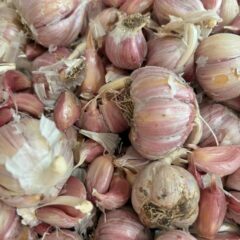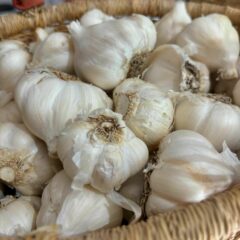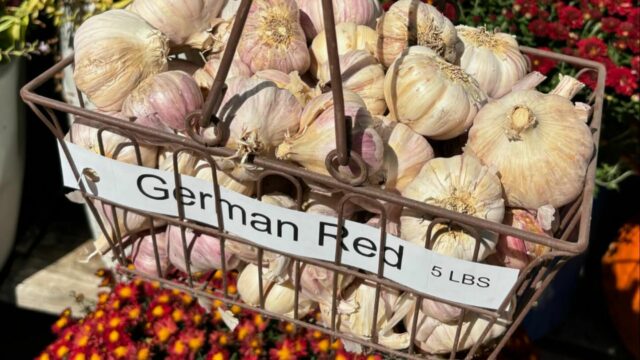Garlic (Allium sativum) has been cultivated for more than 5,000 years! Native to central Asia, naturally disease-resistant garlic is avoided by most pests and is easy to grow.
Garlic is best planted in our area from mid-November to mid-December. Your goal is to get the cloves in the ground so that roots develop but greenery doesn’t poke up through the soil surface. It takes about nine months to reach harvest.


Two Types of Garlic
Hardneck garlic varieties develop a stiff neck or stalk, called a scape, that grows from the center of the bulb. The scape is edible and has a mild garlic flavor. They have large, uniform cloves and store for two to four months. Hardneck garlic is suited to cold climates.
Softneck garlic does not produce a scape, but its soft foliage can be braided once bulbs are harvested. It has a longer shelf life than hardneck, lasting six to eight months after harvest. Softneck is suited to warmer climates with mild winters, though some types of softneck also can be grown in the North.
One pound of hardneck garlic will yield 4-6 pounds of garlic. One pound of softneck garlic should yield 6-10 pounds.
Grocery store garlic is most often grown in California so it’s not cold hardy. Supermarket garlic is also treated to prevent sprouting and may not be disease-free.
Softneck
Nootka Rose is a gorgeous silverskin-type with rose-streaked bulbs. From the San Juan Islands of Washington State, the medium-large bulbs have a strong, garlicky flavor without too much heat. Each bulb yields about 15 to 20 cloves. This variety has excellent storage life, and will remain intact and delicious for up to 12 months!
Inchelium Red garlic is a mid-season Artichoke-type softneck garlic. This Native American variety is from Washington state. Very large purple bulbs have a rich buttery flavor.
Hardneck
Purple Glazer has large, elongated cloves wrapped in a purple-striped paper and a rich flavor with a touch of sweetness with no hot kick or aftertaste. Excellent for roasting and baking.
German Red has hot and spicy flavor. Produces nice large bulbs with rosy pink and brown stripes on the bulb wrapper that are easy to peel. A nice bulb to harvest early while waiting for other garlics. A must grow garlic from old time gardeners of German descent in Idaho.
Planting, Growing & Harvesting
Garlic requires full sun. A minimum of six hours of direct sunlight per day can suffice but plants will do better with 8 or more hours.
Garlic can tolerate poor soils, but adding compost is recommended. Garlic prefers well-drained soil, so avoid heavy clay.
Dig holes four to five inches deep for each clove, then separate the cloves right before planting by peeling off the papery outer skin and pulling individual cloves away from the base of the bulb.
Place one clove per hole, pointy-side up and cover with soil. A light coating of mulch is recommended to keep down weeds and regulate temperature. Space cloves a few inches apart in rows about nine inches apart.
Fertilize garlic in spring and keep the bed weeded until harvest.
If you’ve planted hardneck garlic, it will push out a long stem from the center of each bulb in early summer. Trim it off when a little bud-like area develops towards the end of the curling stem.
It’s important to remove the scapes of hardneck garlic to grow larger bulbs. You can use the scapes like green onions to flavor dishes mild garlic flavor or make into pesto.
Harvesting Garlic
It’s time to harvest garlic when the leaves closest to the ground start to die back and turn yellow or brown, usually in early summer. If you wait too long the paper bulb wrappers can split exposing the bare cloves and reducing storage time.
Lift gently from the soil by digging under each bulb with a trowel or shovel. Shake off the dirt, and let sit in a shady spot or garage to cure.
Unless you’re braiding softneck garlic cut off the tops leaving an inch or two of stem at the top of each bulb.
Damaged bulbs should be used right away. Store the rest in a cool, dry spot.
